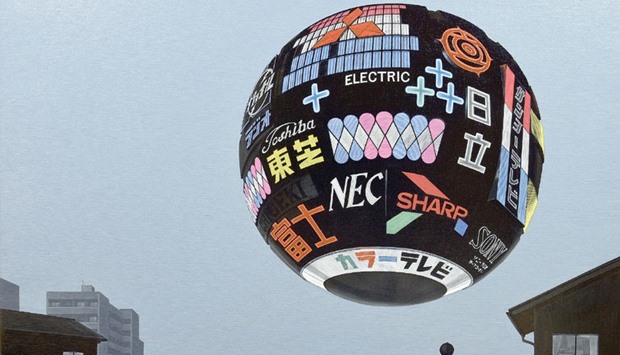
Initiative Star.
Filled with futuristic warnings about human’s tendencies for environmental dominance and over-consumption, this is a fictional world of orb paintings. Japanese artist Masakatsu Sashie presents this imaginary world depicting large, city-like spheres drifting above remains of a destroyed civilisation.
His gigantic orbs are created out of scraps of old constructions from the Showa-period. It is a period of enlightened peace and harmony, period of radiant Japan during the time of reign of the Showa Emperor, Hirohito, from 1926 to 1989. And there are pieces of mass production and mass consumption culture in his work.
Things like vending machines, pachinko parlours or fast food signs and video game components are woven into Sashie’s imagery in his orb painting, creating an orb using a light source. The Japanese artist and his work are coming to town with a solo exhibition at Anima Gallery on May 9.
“Sashie focuses on the idea how with the haphazard increase in populations and depletion of resources, the space is shrinking for humans. He tries to depict in his work how the future cities would look like,” Iliana Kodzhamanova, the Sales and Marketing Executive, Anima Gallery, tells Community.
She says Sashie’s work is easily distinguishable and he is one of the most prominent young Japanese artists. His solo exhibition comes as part of Anima Gallery’s international focus.
“We mostly hold solo exhibitions during different times of the year and our focus is mostly on international artists. Sashie is a distinguished Japanese artist with his work appealing to a large international audience,” says Kodzhamanova.
The artist himself will be present at the opening reception to be held at Anima Gallery on May 9. The exhibition will open to the public the next day.
Sashie’s work revolves around the belief that the coacervate is a universal model and basis for all systems and organisms, simple and complex. The term coacervate, from Latin “to assemble together or cluster,” is defined as a microscopic droplet of assorted organic lipid molecules held together by hydrophobic forces in a surrounding liquid.
They create a locally segregated environment yet their boundaries allow selective absorption from the medium in which they are contained. This assimilation of elements, a primitive form of metabolism, is the basis of the Origin of Life hypothesis set forth by post-Darwin theorist Alexander Oparin in which there is no fundamental difference between living organisms and lifeless matter.
Sashie’s coacervates are often depicted as orb-shaped amalgams of manmade objects suspended over cityscapes.
“Although coacervates exist on a microscopic level, the function of assimilating surrounding matter extends into our world as well as the universe beyond. Selectively absorbing and processing our environment, whether conscious or subliminal, is part of our evolution and results in the composition of who we are, the world we live in, the systems we create and values that are prized,” says the artist in his statement.
The works in this exhibition feature landscapes that resemble landfills comprising towering piles of glowing televisions, vending machines, vehicles and other industrially manufactured products.
The juxtaposition of the detailed subjects and the vastness of their surroundings emphasises a contrast in complexities between these concentrated small worlds and the expansiveness of the larger world around them.
Through these combinations, the artist intends to convey the ubiquitous commonality in how functions of microscopic systems extrapolate to the greater universe. Masakatsu was born in 1974 in the city of Kanazawa in Ishikawa Prefecture. He received an MFA from the Kanazaw College of Art in 2000.
His birth town is widely known for its rich cultural traditions in arts and crafts. Kanazawa has very difficult geographical accessibility and it owes to this fact a rather unique culture development.
Sashie received his MFA from the Kanazawa College of Art in 2000. Sashie has exhibited throughout Asia and the United States and his work is included in private and corporate collections internationally.
With a lifelong interest in model making and having grown up in a virtual diorama, Sashie’s intricately detailed oil paintings depict a world where the common objects of modern industrialisation take on often oppressive forms.
These haunting vistas are often dominated by an orb, a substantial figure, made of an amalgam of the remnants of human existence. The contrast between the detail and complexity of the orb and the surrounding environment impresses upon the viewer the co-existence of small microcosms within the larger outer world.
Without showing preference to either world, Masakatsu Sashie paints two opposite worlds as equals with the intent of drawing the viewer into the space and having them reflect on society and its values.
